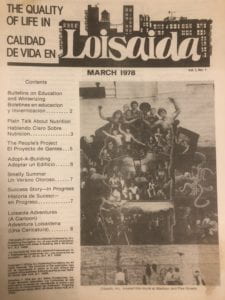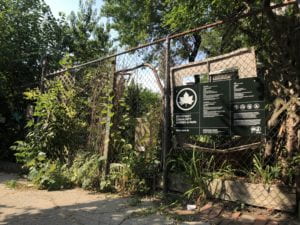The Lower East Side has history tied particularly to Latin American culture, and more specifically, Nuyorican (New York/Puerto Rican) culture. The Loisaida center is a cultural center focused on providing programming and training as well as preserving culture through providing space and funding for artwork, which according to their website is part of addressing serious economic issues ad disenfranchisement. The Loisaida Center itself was formally incorporated into New York State as a local development corporation in 1978 (From Loisaida Inc.), but the organization was born out of a movement of Puerto Rican and Hispanic activists in the years before this (Also from Loisaida) In the Lower East Side, activism is at the core of the neighborhood history, due to the constant marginalization of the people living there. The neighborhood has been defined by its Latin American heritage ever since migration from Puerto Rico and some other Latin American countries began to occur. Though there were a number of migrants from Puerto Rico to New York City before World War II, following that war and the great depression was the period of “The Great Migration” of Puerto Rican’s to New York, where between 1946 and 1950 an estimated 31,000 Puerto Ricans Came over each year. To be brief, more migration occurred in the 50’s 60’s and 70’s, where the between the 1970 and 1990 was the peak of Puerto Rican Population in New York City and the Lower East Side. I have found through looking at historical archives at the Loisaida Center, Nuyorican Poetry has been a crucial element of the Neighborhood’s identity. In March of 1978, a bilingual publication was launched called, The Quality of Life in Loisaida.In the six papers of the volume that is in the collection, most papers include a section with poetry. Currently, the Nuyorican Poets Cafe resides on 3rd street between avenue B and C.

The First issue and Volume of “The Quality of Life in Loisaida” Bilingual Newspaper, Published in March 1978
Community Gardens have also been an extremely important part of Loisaida, which have shown to be a useful space for artwork and community. The Loisaida center is positioned next to two large and historically important gardens in the Lower East Side, which is important for the organization as they are a part of working with gardens to provide space for artists. Also, the activism that eventually created Loisaida Inc, partly spurred from community garden activism as well as housing rights. This is why sustainability and community (as well as the arts in regards to my previous points) are such important pillars for the Loisaida Center.

9th st community garden, which sits directly across from the Loisaida Center
At this moment in time. The Center is focused on preserving this rich heritage and doing all they can to fight the displacement of the community due to gentrification. They are working on innovative ways to train a workforce for a new age of technology, as well as continuing the process of placemaking for innovative artists and community members. Each year the Loisaida festival happens at the end of May, which is where I took the picture on the home page of this website. It is through programs like these that keep that history alive and relevant. All ages groups of the community can be seen at the festival and it represents a solidarity and unity of generations.

Thank you for this narrative of the Loisaida’s history and of the history of the Center itself. It’s never been totally clear to me who the original stakeholders were in creating Loisaida Inc. Were they politicians? Were they service providers? Was it the city? Who? It’s particularly interesting because there are other organizations working in the area at the same time. So what’s their relationship, especially considering how fraught and fragmented some of the politics of the Lower East Side can be? I’m also really interested in you thinking through how The Loisaida Center conceptualizes the terms “preservation” and “displacement” since they do so in non-traditional ways. For example, they are not trying to preserve historic buildings, are they? And they are not fighting landlords or developers, are they? This is something worth exploring further, I think.